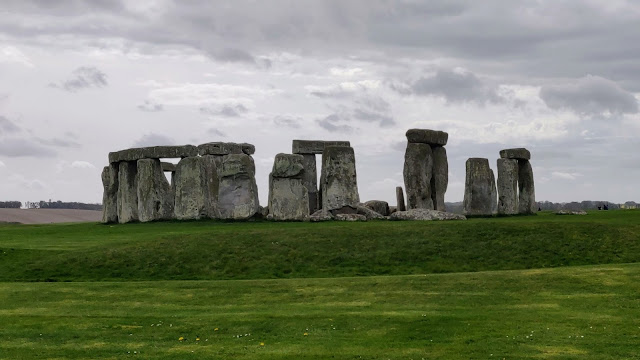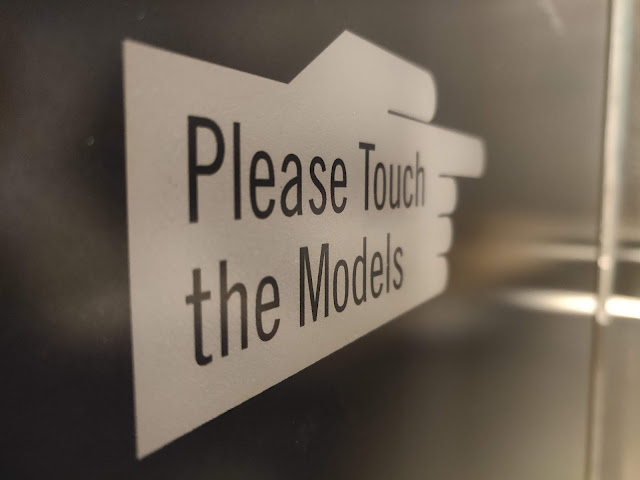On Saturday morning I crested a hill on the A303 just past Amesbury and my brain yelled something that I imagine a million and more brains, over thousands of years, have yelled before mine:
"What the hell is that!?"
It did this despite having made a special trip to the area to see that which caused the outburst, and it wasn't even the first time it had done so. As old as the pyramids (or thereabouts) and at once out of place yet totally fitting, Stonehenge is a phenomenal thing to see rising out of the Wiltshire countryside - even when you're expecting it.

|
| A photograph of Stonehenge, taken by me, but looking for all the world like a cardboard cutout on a movie set. |
I love museums and heritage sites of all shapes, sizes and themes, but Stonehenge has always commanded a particular fascination. I'm neither religious nor spiritual, but visiting always feels like something of a pilgrimage. I work with museums and I'm also a maths communicator, both of which affect the way I look at cultural experiences: this post is intended to document some of the thoughts I had regarding the potential of Stonehenge's story for enriching mathematical understanding (and vice-versa).
It's worth noting that if you're a teacher or parent wishing to use Stonehenge to provide context or inspiration for students studying maths you've got some work to do[1]: as with most museums, English Heritage (the guardians of the site) currently provide nothing in the way of maths-focused resources or programming (that I have discovered)[2].
EDIT: After sharing this post on LinkedIn, Stonehenge's Learning Programme Coordinator responded: "There is already a bit of maths in our facilitated workshops & lots more to come in the STEM Learning Programme." I asked if there were more details, and she responded:
"We explore how the stones were moved & raised as part of the facilitated Neolithic Life workshop & our teachers kit has a biscuit henge activity & scale model activity which are linked to the maths curriculum. All info for teachers can be accessed here: https://www.english-heritage.org.uk/visit/places/stonehenge/school-visits/ Schools can visit any of our sites for free and we have lots of downloadable resources on our website or they can get in touch with us directly if they need more info!"
I downloaded the Teachers' Kit to find that there are a couple of mentions of maths in there (woohoo!). Unfortunately, I can't link to any specific trip details as I haven't discovered anything on the school visits part of the website that mentions maths yet (even an otherwise comprehensive list of curriculum links doesn't mention maths). Follow (or join in) the conversation on the LinkedIn post here.
Here are some thoughts on where I'd start digging for maths:
On a superficial level, mathematical vocabulary is dotted throughout Stonehenge's exhibitions and guide material, as with any other site. For example, as a circular monument its diameter is used to describe the size of the site; and size, shape and mass are discussed as key features of the various stones, which naturally includes a variety of units of measurement.
In the visitor centre, an entire wall is set aside to display a collection of quotes relating to Stonehenge made by a variety of famous people throughout history. One of these is rock musician Nigel Tufnel[3] in his 1984 Single Stonehenge: "No one knows who they were or what they were doing."

|
| A photograph of the quote mentioned above, just in case anyone doubted it. |
This lyric succinctly sums up modern humanity's knowledge regarding what Stonehenge was actually for. There have been many suggestions over the years (from the sublime to the ridiculous, and everything in between) but the background to most boils down to some sort of geometric study of the site, ranging from explorations of the properties of circles and other shapes and what they might have meant to the people of the time, to trigonometric investigations involving the position of the Sun and other astronomical objects at different times of the year.

|
| Model behaviour from a museum. |
On the subject of geometry, extensive surveys of the site have been conducted which require all sorts of mathematical techniques, and these have been used to create scale maps, diagrams and models. Versions of these, ranging from posters and snowglobes to jewellery and skittle sets are available in the shop, but there is also a satisfyingly chunky quartet of scale models in the main exhibition which presents the site's configuration at different points in its history. I love scale models in museums (any heritage site that doesn't have one is lacking an important experiential tool) but these four are particularly satisfying: we're not merely allowed to touch them; there's a sign pleading with us to do so.

|
| Museum models are so often trapped in glass cases, but these are literally pleading to be touched. |
Scale models represent excellent opportunities for all sorts of mathematical investigation that could be easily adjusted to suit the age, ability, experience, confidence and interest of students taking part. Simple ideas may involve interacting with scale drawings or models to explore sizes and extents in different contexts, including recreating aspects of them at home or in the school hall[6]. More detailed possibilities include surveying the original site to an appropriate degree of accuracy and using the results to (mathematically or physically) construct detailed maps, diagrams or models.
Outside the exhibition, there is a full-sized replica of a sarsen stone resting on rollers. There's a rope attached to one end, and visitors are encouraged to take hold and pull. A display (when it's working, and I'm pretty sure it hasn't been for a while) tells you how many of you would be needed to budge the stone. This is a wonderfully simple idea, but potentially opens doors to mathematical activities and investigations suitable for all levels of experience and confidence.

|
| Could you move the sarsen stone? (Spoiler: No.) |
I haven't produced any resources or solutions for using Stonehenge to explore mathematics (or, of course, for using mathematics to explore Stonehenge), not least because it would be a lot of work[4]: this is little more than stream-of-consciousness waffle about where I might start thinking about these things if and when I have the time, and I'm sharing them in case they prove interesting or useful to someone else.
If you've had any ideas on the Stonehenge+Mathematics theme (or if you've created any relevant resources that you'd like me to share) I'd love to hear about them: post a comment below or get in touch!
Footnotes
- Do consider getting in touch with them: Many a museum educator has told me that they don't offer opportunities to explore the mathematics in their stories because maths teachers aren't interested in them. If more teachers[7] let them know that they're wrong then we might start to see some change in the sector. [back]
- This is far from unusual and if you'd like to help to change this, see footnote 1. [back]
- Unique amongst those people represented on the wall for being entirely fictitious. I have no idea whether the person or committee who agreed on his inclusion knew this, and I'm not sure which answer would bring me greater joy. [back]
- I could find some time in my work schedule, should someone involved with Stonehenge have some funding available[5]. [back]
- This is not a trick that is specific to Stonehenge, either. I could conjure up some maths (or, rather, find the maths that's already there) for any museum, art gallery or heritage site. Try me! [back]
- If you've seen This is Spinal Tap you'll understand why improving public understanding of these ideas is particularly relevant (spoiler). [back]
- Even if you're not a maths teacher and you want to see more museums enriching their stories by embracing the maths that exists within them, then definitely get in touch and let them know: they leave it out because they think that's what you want. [back]









No comments:
Post a Comment
Hi, thanks for commenting. If you feel passionately about anything I've posted, please feel free to make your views known but please take the time to make sure that your comments are rational, considered and suitable for any audience.
Thanks for reading!